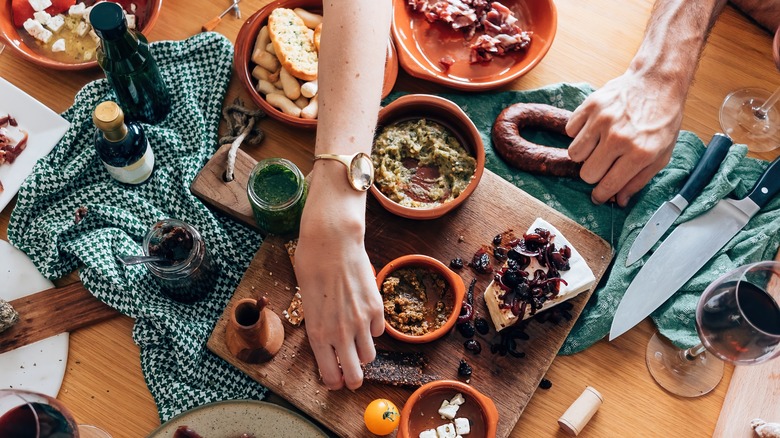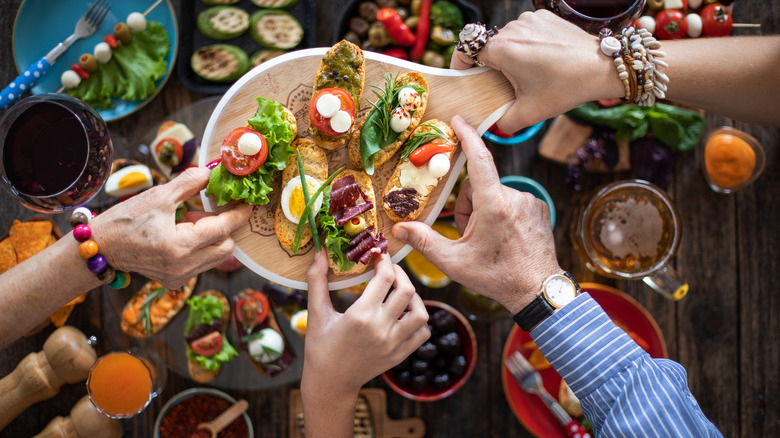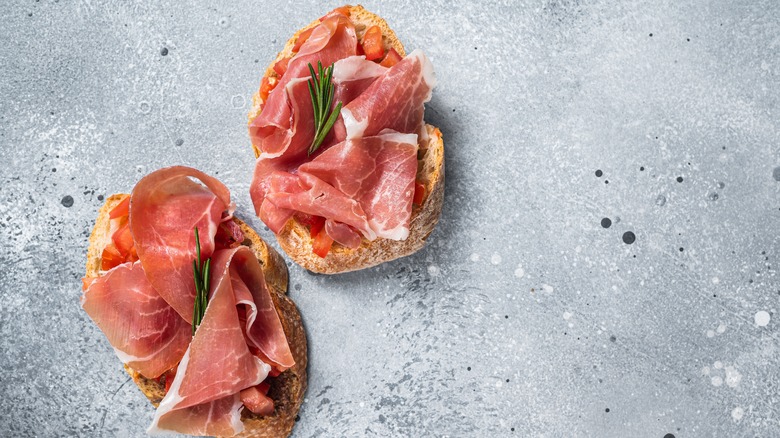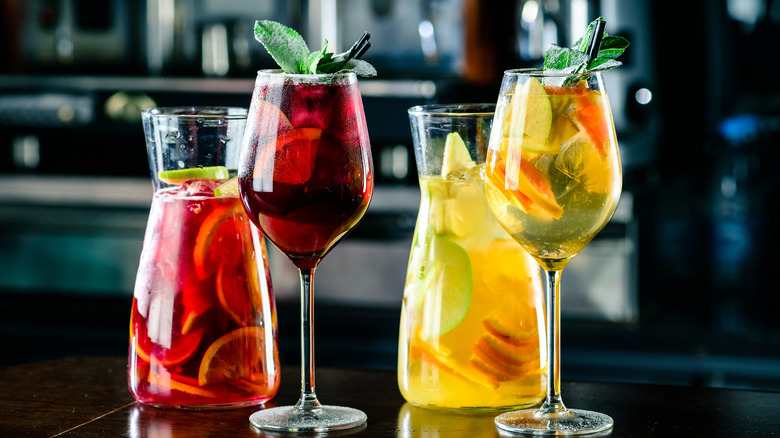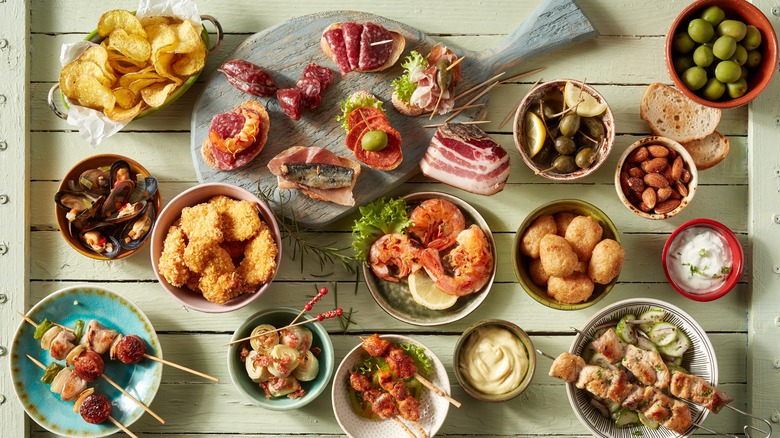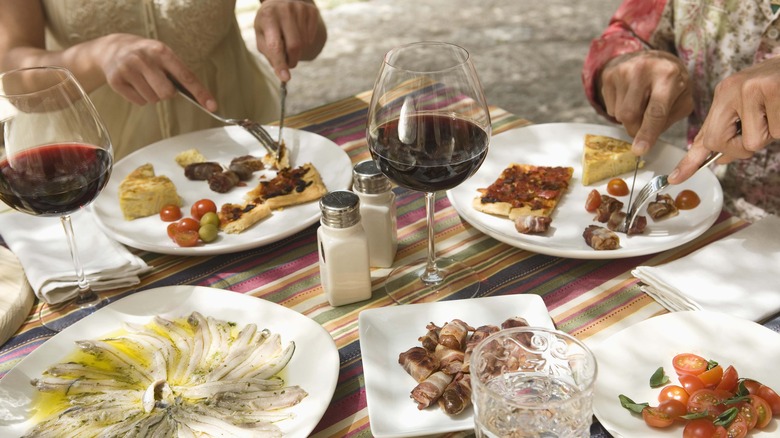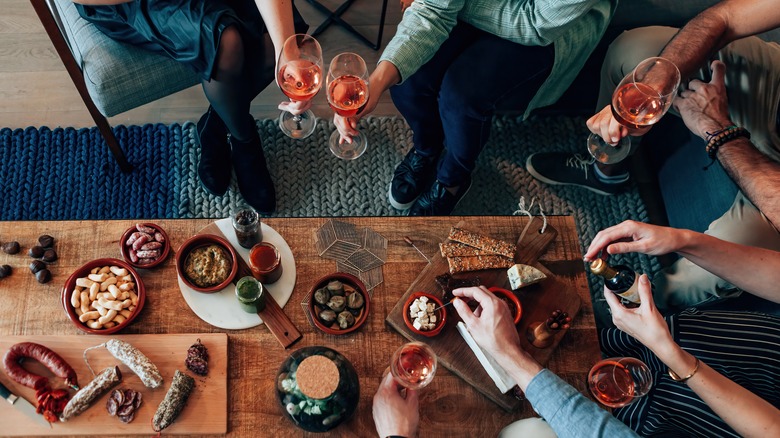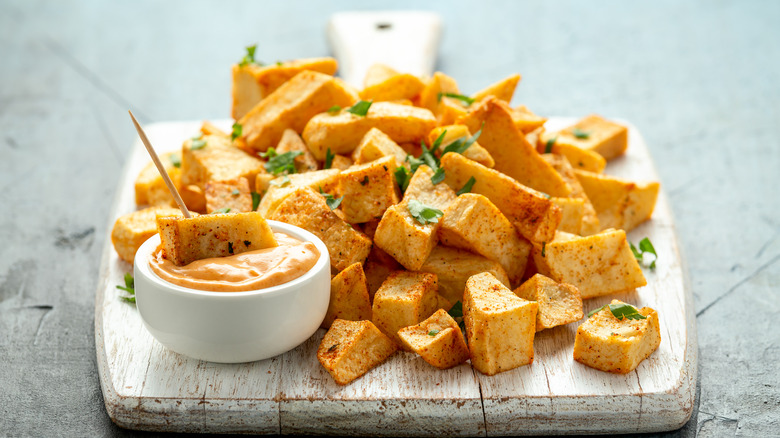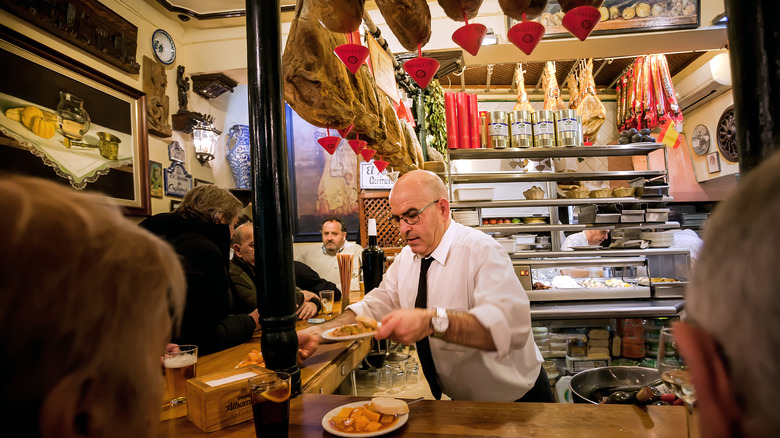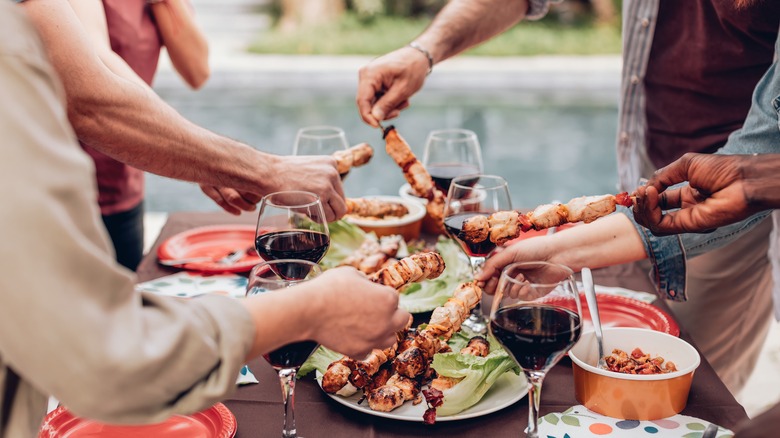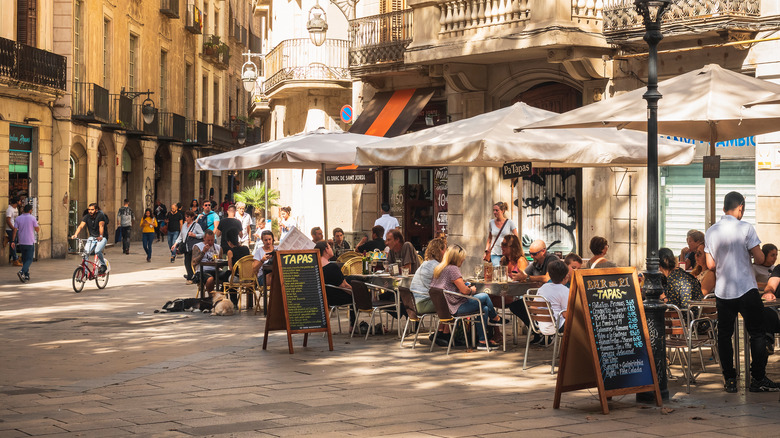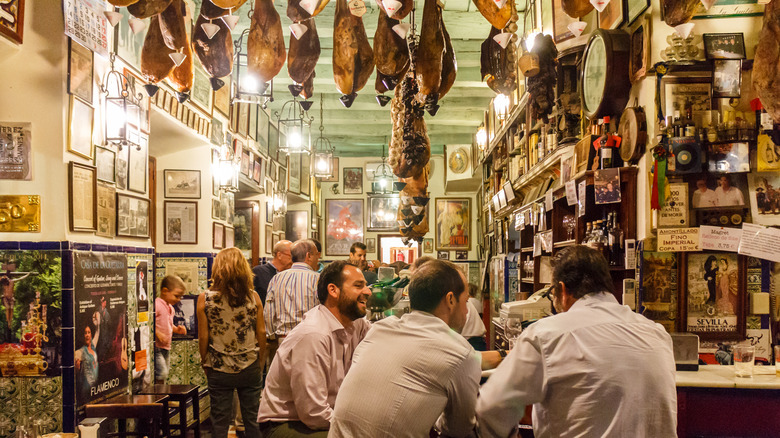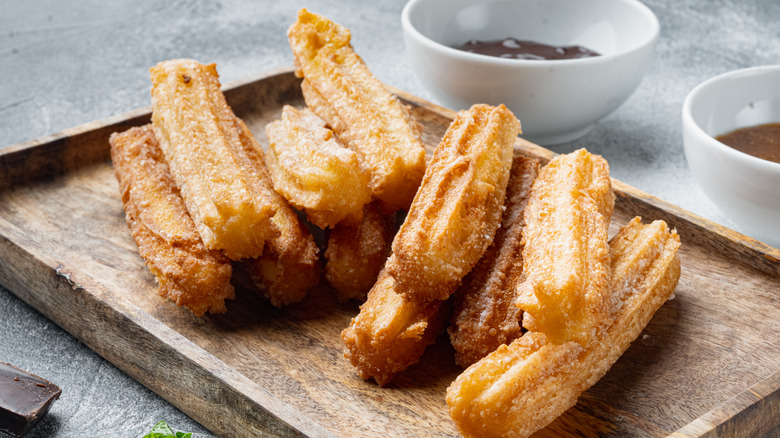13 Biggest Mistakes Everyone Makes When Ordering Tapas
Tapas have taken the United States by storm, thanks at least in part to Spanish chefs like José Andrés who brought this style of dining overseas. Although he came to the United States over 30 years ago with little to his name, Andrés now owns 31 restaurants, primarily modeled after the small plates design he popularized. Today, this practice of serving small plates is omnipresent in the U.S. urban dining scene moving beyond Spanish cuisine.
While tapas restaurants are a relatively new phenomenon in the U.S., this dining style has been in practice in Spain for ages. Numerous sources claim that tapas can be traced back to 13th-century King Alfonso X, whose health issues required him to drink copious amounts of wine. He would eat small portions of food between meals to lessen the effect of the alcohol. According to the legend, when he recovered from his illness, he decreed that everyone should have a bit of food with alcohol (via The Culture Trip).
This is just one of the theories about the origin of tapas, but regardless of how and when it started, this dining style has been cemented into Spanish culture. It's a major activity that tourists in Spain look forward to experiencing, and tapas restaurants can now be found around the globe from the U.S. to Australia. Whether you are visiting a tapas restaurant in New York or Seville, it's important to avoid these key mistakes to get the most out of your meal.
Going by yourself
No, we aren't taking a stance against dining alone. Going to a restaurant by yourself can be a worthwhile venture, but there are some situations where riding solo just doesn't make sense. In the case of tapas, you'd be limiting your experience.
There is no shortage of tapas dishes to try. Cod fritters, Catalan spinach, boquerones, Iberico ham, croquetas. The list is endless. What isn't endless is your stomach's ability to intake food. Under the standard dining style, you typically order a single entrée with potentially an appetizer or dessert. If you do all three, it's likely to be more food than you can eat.
With the smaller portions in tapas, you have a greater ability to add variety to your meal. This is what sets small plates apart. There is no set amount of tapas that will leave you feeling full. It will depend on the place and the type of dishes you order. However, the general consensus is to get two to three dishes per person. If you are alone, that's just a couple of menu items. When you go with a group, your meal has just expanded while still providing the same amount of food. In a group of four people, you could potentially get a taste of 12 different dishes. As empowering as dining alone can be, it's best to grab some friends when going out for tapas. Besides, eating tapas is a very sociable activity, meant for engaging with others while you eat and drink.
Not doing research beforehand
Not all tapas bars are the same. You can't walk into any place and expect the croquetas to be just as good as the last ones you tried. That would be like expecting to get a superb steak at every restaurant, which would be ridiculous if you happen to be in one that focuses on plant-based cooking. Instead, you'd probably want to order the chickpea dish that everyone raves about online.
You don't have to become an expert in every restaurant you visit, but do some research. Get to know the can't-miss dishes in the city you are visiting. Find out who has the best Iberico ham and where you should order empanadas. Check reviews and social media, and if you are lucky enough, speak to locals. Find out what people are praising and what might be best to skip. Even when dining with a group, it's impossible to try every tapa.
Here are some great examples of how research can improve your meal. Bar del Pla in El Born (a neighborhood in Barcelona) is known to have the best squid ink croquetas and divine beef cheeks. Prioritize these dishes before trying other things. The same can be applied to tapas restaurants outside of Spain. Huertas in the East Village of New York City serves a house-made sausage that is studded with green garlic. If you didn't know this was a specialty from Chef Jonah Miller, you might miss out on one of the best things on the menu.
Not ordering drinks first
Another tapas origin story involves a completely different King Alfonso, who ruled in the early 20th century. This legend claims that a waiter covered King Alfonso XIII's glass of sherry with a sausage to prevent sand from blowing into it. Barcelona Home explains that the culinary term "tapas" comes from the Spanish verb tapar ("to cover") or the noun tapa ("lid"). These little plates of food can also act as a lid to protect your drink from dirt, flies, and other unwelcome pests.
Given the long association between these tiny-portioned meals and alcohol, drinking has naturally been a part of the experience. Tapas restaurants in Spain and abroad will likely have a good list of wine, sherry, and cocktails like sangria. Before you order any food, make sure to place your drink order if you are partaking. Not only could these drinks pair well with your food, but you may also benefit from your patience. In Spain, free tapas were once widely expected with alcohol purchases (via El Meson). For this reason, it is a good idea to start by ordering a drink and wait to see if you get a complimentary bite. Just don't expect it everywhere. This age-old practice is not as common as it once was and can vary from region to region. It's a nice gesture, but do not demand it. If you notice that no one is getting free tapas, proceed to order your food.
Ordering everything at once
Tapas menus can be overwhelming with options. We all can suffer from our eyes being bigger than our stomachs. As much as we might want to try everything on the menu, that's not realistic in one visit.
Talk over the menu with your fellow diners and decide what you want to try the most. Once a consensus is made, don't give your whole order to the waiter at once. Sure, no one will stop you from doing so, but here's why it's a bad idea. When you order all at once, you are likely to get a rush of food at your table all around the same time. In general, you can expect the waiter to bring out your dishes as they are finished cooking. The kitchen typically won't stagger your order. They have too many other things to track during service. If you order all your food at the start, you'll have dishes that get cold before you even touch them. El Meson recommends pacing yourself by ordering items are you are ready to eat them. If you are still in the mood for more food, you can always order another round.
Expecting large portions
Compared to the typical American restaurant portion, tapas can seem like a scarce amount of food. The difference is you are not ordering a single entrée and calling it a meal. Remember the general rule of two to three tapas per person. An important aspect of tapas to understand is portion sizing. Don't order the meatballs and automatically think you'll be getting a huge platter.
Learn how to read the menu. This will help you build a meal that will satiate your hunger. For starters, know the difference between tapas and pintxos. Tapas are typically smaller portions of full dishes you might see at other dining establishments, but pintxos are a thing of their own. Pintxos, which come from the Basque country, are little one-bite treats that can't be shared. If you notice that pintxos are the cheapest items on the menu, that's likely due to the minuscule portion. Keep these sizes in mind when you are dining. You'd need a lot of pintxos to feel full. If you are exceptionally hungry, look for menu items labeled as "raciones." This term translates to "portion," making it an appropriate word for these larger servings of food. While a tapa could easily be consumed by one person, raciones are made to be shared with multiple people. Boquerones are typically served as a ración, meant for passing around the table like family-style.
Ordering individual plates
For unaccustomed patrons, one of the hardest aspects of small-plates dining to wrap their heads around is the act of sharing food. You may recoil at the idea of eating off the same plate as someone else, but tapas is an opportunity to expand your horizons. Instead of ordering a single dish that only you will consume, tapas are meant to be shared. That's why meals in this style are sometimes called "shared plates."
In 2012, Pete Wells of the New York Times stated that the U.S. dining culture was desperately trying to turn small plates into dinner when this goes against the traditional structure of tapas. These small bites and drinks are meant to get you through to the late Spanish dinner hour, which typically is not earlier than 10:00 p.m. when many Americans may already be in bed. Over 10 years later, it seems we are too far down the path Wells warned about, since small plates as dinner seem to have stuck.
In Spain, getting just a bite or two of each dish can be enough to satisfy your late-afternoon peckish state. The traditional time to go out for tapas in Spain is early afternoon or early evening. You can order dishes just for yourself, but as discussed earlier, you won't get to try as much from the menu. Tapas are meant to be a social experience, and much like American happy hour, sharing food over a round of drinks is a great way to connect with others.
Sticking to just what you know
We all love patatas bravas, and there is nothing wrong with that. What's not to enjoy about crispy fried potatoes with a flavorful sauce? Patatas bravas is one of the Spanish tapas you need to try, but it is not the only one.
If you find yourself gravitating towards the same two or three dishes every time you go out for tapas, challenge yourself to be brave on your next trip and try something outside your comfort zone. Give dishes like pulpo a la gallega a chance. A Galician specialty, this tender octopus is served over potatoes and then doused with olive oil and smoked Spanish paprika (called pimentón). Even if you get a little freaked out about eating tentacles, this simple dish will rock your taste buds.
What about a vegetable dish? Fans of ratatouille will love pisto Manchego. No, there is no Manchego cheese in this tapa. Hailing from La Mancha (the home of legendary Spanish literature character Don Quixote) pisto Manchego is similar to its French cousin but with the addition of a generous amount of Spanish olive oil, and it's often served with eggs poached directly in the braising vegetables.
Not asking questions
It is okay to not know everything about tapas, even if you do your research. You are in unfamiliar territory, and that can feel stressful. However, there are plenty of ways to feel confident in your dining choices.
Whether in Spain or abroad, don't be afraid to converse with your waiter or bartender. The waitstaff will be the best experts on the food and drinks at their establishment. Asking for advice from the bartender won't even make you seem like an out-of-place tourist. Spaniards frequently ask bartenders for recommendations at tapas bars, and so should you (via Totally Spain Travel).
Another great place for recommendations is the hotel staff at your accommodations. They can give advice on where to go and what places to avoid. In popular destinations, there will inevitably be a lot of tourist traps, but if you go where the locals hang, you will be in great company.
Asking to split the bill
Splitting bills is typically a nightmare for servers in the U.S. Not all requests to split the bill are horrendous. It's the party of 12 who give the waiter 12 credit cards, asking them to charge a specific amount to each card based on the price of each person's food. It's one of the biggest headaches to deal with during a busy service. Thank goodness that apps like Venmo came along to make bill splitting much easier.
With tapas, it is even more difficult to accurately split a bill. In fact, it's best to not even try. With all the food being shared, how could you possibly add up who should owe what? Instead, plan to evenly contribute to an evening of tapas. Participants in a TripAdvisor forum advised against even attempting to get separate checks at tapas bars in Spain. One person even suggested the bartender may pretend to not understand you if you ask them to do this. Given the quick flow of people in and out of these bars during peak hours, they don't have time to figure out split payments. You don't pay until after you finish eating at Spanish tapas bars, so you won't be able to just alternate paying for each round of food and drinks. Recommendations for splitting the cost include pooling cash, alternating nights for who pays, or even alternating who pays throughout the night if you go bar hopping.
Expecting tapas to be the same everywhere
Much like the United States, India, China, Italy, and countless other countries, Spain's cuisine has traditionally been regional, though modern lifestyles have blurred some of the regional distinctions. Still, tapas will be served differently throughout the regions of Spain. If you have the opportunity to travel around the country, do not expect the dining scene to have a universal experience.
For example, in coastal cities, you will naturally find much more seafood on menus than when dining inland. You might get octopus in Galicia and calamari in Andalusia. In Extremadura, you'll find the best Iberico ham and in La Mancha, the same can be said for Manchego cheese (via Devour Tours). It all goes back to doing a little research. Get to know the local specialties and customs of each region and within regions, as well. For example, Devour Tours warns that in the region of Andalucia, Granada is known for giving out free tapas, but you should not expect them in Seville.
Not knowing local customs
Traveling can leave you lost and confused when you encounter new customs, and let's not pretend this is reserved for foreign travels. People from faraway states will probably always be perplexed by the sight of Pittsburghers eating a salad with fries in it. The same can be true when you visit unfamiliar lands.
Knowing the local customs of the city you are visiting is always a good idea, but sometimes they may give you that extra little boost towards dining like a local. In Spanish food etiquette, it is customary to throw garbage on the floor. Spanish Sabores says that a good way to spot a quality tapas bar is if you see napkins on the ground. When there are a lot of napkins and other garbage on the floor, you will know that is a popular place to get tapas. Contrary to U.S. dining customs, garbage is a good thing. Maybe one person's trash really is another person's treasure, if their desired treasure is great tapas food.
Choosing just one location
This tip is very specific to Spain. In the U.S., you are unlikely to go bar hopping when dining on tapas because you might have to travel across the city to find another spot. You're most likely going to be getting your fill of tapas by staying stationary.
In Spain, however, you are limiting your experience by staying in one location. Spanish cities have distinct streets that are famously lined with rows of tapas bars, like Calle Navas in Granada (via Condé Nast Traveller). You can easily visit several bars in one evening by just walking down the street. Simply choose a bar, order a round of drinks and tapas, pay your bill, and move on to the next place. Trafalgar Tours claims this will have you dining like the locals. Another benefit is that if you aren't impressed by the first bar you chose, there are dozens more along the street to try.
Skipping dessert
Many Spaniards would probably disagree with this last "mistake" on our list, but maybe they'd allow this little bit of rebellion. In Spain, getting dessert after tapas is not a common practice because it is not considered a full meal. If you get the chance to visit Spain, it might be worthwhile to feign ignorance with this convention.
Spain has so many delectable desserts to offer. When your sweet tooth calls during tapas, there are ways to satisfy your craving. Some bars might have an a-la-carte menu where you can order desserts like arroz con leche (rice pudding) or flan. If they don't, you can always hit up a churro stand on your way back to your hotel. Churros are Spain's version of fried dough.
Tapas restaurants in the United States make it a little easier to end your meal with dessert. Since these restaurants are often visited in lieu of dinner, most tapas places in the U.S. will have a full dessert menu to help you get your sugar fix.
